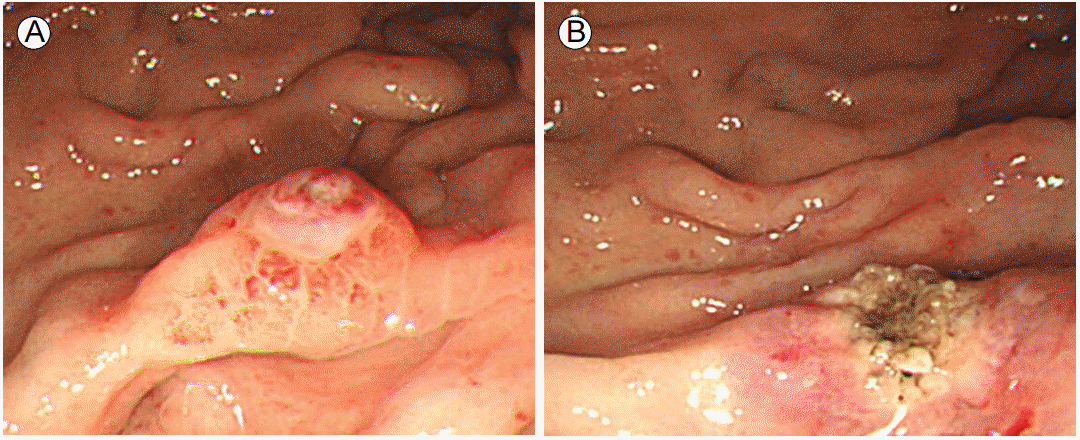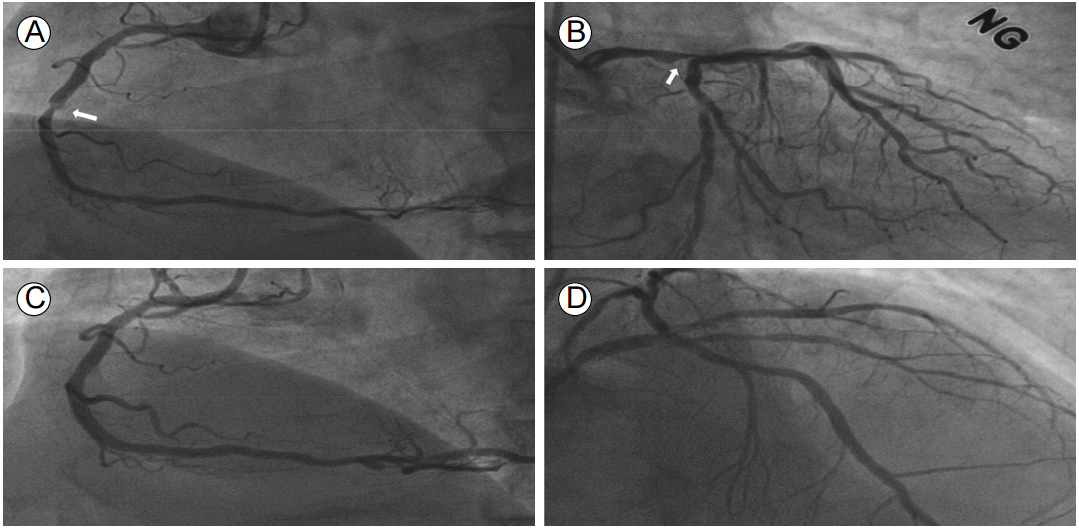мДЬ л°†
мК§нЕРнКЄнШИм†Дм¶ЭмЭА лУЬлђЉмІАлІМ, мЭЉлЛ® л∞ЬмГЭнХШл©і мЛђкЈЉк≤љмГЙмЬЉл°Ь л∞ЬнШДнХШлКФ к≤љмЪ∞к∞А лІОк≥† мЭімЧР лФ∞лЭЉ мВђлІЭ땆мЭі лЖТлЛ§. мµЬкЈЉ мІАмє®мЧРмДЬлКФ мК§нЕРнКЄнШИм†Дм¶ЭмЭД мШИл∞©нХШкЄ∞ мЬДнХШмЧђ кЄЙмД± кіАлПЩлІ•м¶ЭнЫДкµ∞(acute coronary syndrome) нЩШмЮРмЧРмДЬ кіАмГБлПЩлІ•м§СмЮђмИ† м†ДнЫД aspirinк≥Љ clopidogrelмЭШ л≥µнХ© нХ≠нШИмЖМнМРм†Ьл•Љ лґАнХШмЪ©лЯЙ(loading dose)к≥Љ мЬ†мІАмЪ©лЯЙ(maintenance dose)мЬЉл°Ь нИђмЧђнХШкЄ∞л•Љ кґМк≥†нХЬлЛ§[1]. нХШмІАлІМ кЄЙмД± кіАлПЩлІ•м¶ЭнЫДкµ∞ нЩШмЮРмЧРмДЬ мЛђк∞БнХЬ мґЬнШИмЭі нХ®кїШ лПЩл∞ШлРШмЧИмЭД к≤љмЪ∞мЧР кіАмГБлПЩлІ•м§СмЮђмИ†мЭД мЛЬнЦЙнХ† м†Бм†ИнХЬ мЛЬм†Р л∞П нХ≠нШИмЖМнМРм†ЬмЭШ мВђмЪ©мЭД к≤∞м†ХнХШлКФ к≤ГмЭА мЙљмІА мХКлЛ§. мґЬнШИл°Ь мЭЄнХЬ лґИмґ©лґДнХЬ нХ≠нШИмЖМнМРм†Ь мВђмЪ©к≥Љ мґЬнШИ л∞П мИШнШИл°Ь мЭЄнХЬ нШИмЖМнМР нЩЬлПЩмД±мЭШ м¶Эк∞АлКФ мК§нЕРнКЄнШИм†Дм¶ЭмЭШ мЬДнЧШмЭД м¶Эк∞АмЛЬнВђ мИШ мЮИлЛ§. мЪ∞л¶ђлКФ мЬДмґЬнШИ нЩШмЮРмЧРмДЬ лЛ§нШИкіА кіАмГБлПЩлІ•м§СмЮђмИ† мІБнЫД лПЩмЛЬмЧР л∞ЬмГЭнХЬ кЄЙмД± мК§нЕРнКЄнШИм†Дм¶Э м¶Эл°Ал•Љ к≤љнЧШнХШмЧђ л≥ік≥†нХШк≥†мЮР нХЬлЛ§.
м¶Э л°А
59мДЄ лВ®мЮРк∞А 2мЭЉ м†ДлґАнД∞ л∞ЬмГЭнХЬ нЭСмГЙл≥А, мЦімІАлЯђмЫАм¶Э л∞П нЭЙнЖµмЬЉл°Ь мЭСкЄЙмЛ§мЧР лВімЫРнХШмШАлЛ§. нЩЬ놕 мІХнЫДлКФ 119/78 mmHg, лІ•л∞Х 98нЪМ/лґД, нШЄнЭ°мИШ 16нЪМ/лґД, м≤імШ® 37.3вДГмШАмЬЉл©∞ мІБмЮ•мИШмІА к≤АмВђмЧРмДЬ нЭСмГЙл≥АмЭі нЩХмЭЄлРШмЧИлЛ§. мЛђм†ДлПДмЧРмДЬлКФ 5лЕД м†Д мЛђм†ДлПДмЩА лєДкµРнХШмЧђ ST лґДм†ИмЭШ мЬ†мЭШнХЬ л≥АнЩФлКФ мЧЖмЧИк≥†, CK-MB 3.55 ng/mL, troponin I 0.078 ng/mLл°Ь мЛђкЈЉнЪ®мЖМмЭШ мГБмКєлПД кіАм∞∞лРШмІА мХКмХШлЛ§. лІРміИнШИмХ° к≤АмВђмЧРмДЬлКФ нШИмГЙмЖМ 9.6 g/dLмЭШ лєИнШИмЭі нЩХмЭЄлРШмЦі лВімЛЬк≤љмЭД мЛЬнЦЙнХШмШАк≥†, мЬД м≤ілґА лМАлІМлґАмЬДмЧРмДЬ нШИкіАмЭі лЕЄмґЬлРЬ Dieulafoy's lesionмЭі нЩХмЭЄлРШмЦі мІАнШИмИ†мЭД мЛЬнЦЙнХШмШАлЛ§(Fig. 1).
мЭінЫД нЩШмЮРлКФ мЬДмВ∞мЦµм†Ьм†Ь м†ХлІ• нИђмЧђл•Љ мЬ†мІАнХШл©∞ 2 unitмЭШ м†БнШИкµђ мИШнШИмЭД мЛЬнЦЙнХШмШАк≥† нШИмГЙмЖМк∞А 11.4 g/dLл°Ь мГБмКєлРШмЧИмЬЉлВШ нЬімЛЭ м§СмЧРлПД Canadian Cardiovascular Society class 3мЭШ нЭЙнЖµмЭД нШЄмЖМнХШмШАлЛ§. кЈЄлКФ 7лЕД м†Д mixed angina л∞П л∞ЬмЮСмД± мЛђл∞©мДЄлПЩмЭД мІДлЛ®л∞Ык≥† aspirin, diltiazem, nitrateл•Љ л≥µмЪ© м§СмЭімЧИлЛ§. мґЬнШИмЭШ мЮђл∞Ь мШИл∞©мЭД мЬДнХі мЭСкЄЙмЛ§ лВімЫР нЫДлґАнД∞ aspirinмЭД м§СлЛ®нХШмШАк≥†, nitroglycerin м†ХлІ• нИђмЧђл•Љ мЬ†мІАнХШл©імДЬ мІСм§С кіАм∞∞мЭД мЬДнХі м§СнЩШмЮРмЛ§л°Ь мЮЕмЫРнХШмШАлЛ§.
3мЭЉ лТ§ мЛЬнЦЙнХЬ лВімЛЬк≤љмЧРмДЬ мґФк∞Ам†БмЭЄ мґЬнШИмЭі мЧЖмЭМмЭД нЩХмЭЄ нЫД heparin лґАнХШмЪ©лЯЙ л∞П мІАмЖНм†ХлІ•м£ЉмЮЕмЭШ heparinizationмЭД мЛЬмЮСнХШмШАк≥†, aspirin 100 mg, clopidogrel 75 mgмЭД к≤љкµђ нИђмХљнХЬ лТ§ кіАмГБлПЩлІ•м°∞мШБмИ†мЭД мЛЬнЦЙнХШмШАлЛ§. кіАмГБлПЩлІ•м°∞мШБмИ†мЧРмДЬ мЪ∞мЄ° кіАмГБлПЩлІ•(right coronary artery) м§Ск∞ДлґАмЭШ 75% нШСм∞©(Fig. 2A)к≥Љ мҐМм£Љк∞ДлґА кіАмГБлПЩлІ•(left main coronary artery) мЫРмЬДлґАмЭШ 75% нШСм∞©мЭД нЩХмЭЄнХШмШАлЛ§(Fig. 2B). мЪ∞мЄ° кіАмГБлПЩлІ•мЭШ м§Ск∞ДлґАмЧР нТНмД†нЩХмЮ•мИ† нЫД мК§нЕРнКЄ(BiomatrixTM 3.0 √Ч 28 mm, Biosensors International, Singapore)л•Љ мВљмЮЕнХШмШАк≥†(Fig. 2C), мҐМм£Љк∞ДмІА кіАмГБлПЩлІ•мЧРлПДнТНмД†нЩХмЮ•мИ†нЫДмК§нЕРнКЄ(BiomatrixTM3.0√Ч24mm, Biosensors International, Singapore)л•Љ мД±к≥µм†БмЬЉл°Ь мВљмЮЕнХШмШАлЛ§(Fig. 2D).
кіАмГБлПЩлІ•м§СмЮђмИ† нЫД мХљ 15лґД к≤љк≥ЉнЦИмЭД лХМ нЩШмЮРлКФ лЛ§мЛЬ нЭЙнЖµмЭД нШЄмЖМнХШмШАк≥†, лІ•л∞ХмЭі лІМм†ЄмІАмІА мХКмХД м¶ЙмЛЬ мЛђнПРмЖМмГЭмИ†мЭД мЛЬнЦЙнХШмШАлЛ§. міИкЄ∞ мЛђм†ДлПДмЧРмДЬ мЛђмЛ§мДЄлПЩмЭі нЩХмЭЄлРШмЦі 200 Jл°Ь м†ЬмДЄлПЩмЭД мЛЬнЦЙнХШмШАмЬЉл©∞ л∞Шл≥µм†БмЬЉл°Ь мЛђмЛ§лєИлІ•мЭі мІАмЖНлРШмЦі к≤љнФЉм†Б мЛђнПРмИЬнЩШ л≥ім°∞мЮ•мєШ(percutaneous cardiopulmonary support) мВљмЮЕ нЫД кіАмГБлПЩлІ•м°∞мШБмИ†мЭД мЛЬнЦЙнХШмШАлЛ§. кіАмГБлПЩлІ•м°∞мШБмИ†мЧРмДЬ мЪ∞мЄ° кіАмГБлПЩлІ•(Fig. 3A)к≥Љ мҐМм£Љк∞ДмІА кіАмГБлПЩлІ•(Fig. 3B)мЭШ мК§нЕРнКЄ мВљмЮЕлґАмЬДмЭШ мґ©лІМ к≤∞мЖРмЭД л≥імЧђ кЄЙмД± мК§нЕРнКЄнШИм†Дм¶ЭмЬЉл°Ь мІДлЛ®нХШмШАлЛ§. мєінЕМнД∞л°Ь мГЙм†ДнЭ°мЮЕмИ†мЭД мЛЬнЦЙнХШмЧђ(Thrombuster II, Kaneka, Japan) л∞±мГЙ нШИм†ДмЭД нЭ°мЭЄнХШмШАк≥†, мєінЕМнД∞л•Љ нЖµнХі glycoprotein IIb/IIIa мЦµм†Ьм†Ь abciximab 16 mgмЭД кіАмГБлПЩлІ• лВіл°Ь м£ЉмЮЕнХШмШАлЛ§. мЭінЫД лСР лґАмЬДмЧР нТНмД†нЩХмЮ•мИ†(3.0 √Ч 20 mm balloon)мЭД мЛЬнЦЙнХШмШАк≥† мЮђнШСм∞© л∞П нХ©л≥См¶Э л∞ЬмГЭмЭі мЧЖмЭМмЭД нЩХмЭЄ нЫД мЛЬмИ†мЭД лІИлђіл¶ђнХШмШАлЛ§(Fig. 3C and 3D). лЛ§мЭМлВ† мЛЬнЦЙнХЬ нШИмЖМнМРкЄ∞лК• к≤АмВђ(VerifyNow P2Y12 assay)мЧРмДЬ 325 P2Y12 Reaction Unit (PRU)л°Ь нЩХмЭЄлРШмЦі clopidogrel м†АнХ≠мД±мЭі мЮИлКФ к≤ГмЬЉл°Ь нМРлЛ®нХШмШАк≥†, clopidogrelмЭД prasugrel 10 mgмЬЉл°Ь л≥Ак≤љнХШмЧђ мЬ†мІАнХШмШАлЛ§. мЛЬмИ† 2мЭЉмІЄ к≤љнФЉм†Б мЛђнПРмИЬнЩШ л≥ім°∞мЮ•мєШл•Љ м†Ьк±∞нХШмШАк≥† мЛЬмИ† 8мЭЉмІЄ мЛђнШИкіА л∞П мЛ†к≤љнХЩм†БмЭЄ нХ©л≥См¶Эк≥Љ нЫДмЬ†м¶Э мЧЖмЭі нЗімЫРнХШмШАлЛ§.
к≥† м∞∞
мК§нЕРнКЄнШИм†Дм¶ЭмЭА мК§нЕРнКЄ мВљмЮЕ нЫД л∞ЬмГЭнХШлКФ лУЬлђЉмІАлІМ мЛђк∞БнХЬ нХ©л≥См¶ЭмЭік≥†[2], лЛ§нШИкіАмЧРмДЬ лПЩмЛЬмЧР л∞ЬмГЭнХЬ кЄЙмД± мК§нЕРнКЄнШИм†Дм¶ЭмЭА лНФмЪ± лУЬлђЉк≥† мєШл™Ем†БмЭЉ мИШ мЮИлЛ§. мК§нЕРнКЄнШИм†Дм¶ЭмЭШ мЬДнЧШмЪФмЖМлКФ мЛЬмИ† кіА놮 мЪФмЭЄ, нЩШмЮР кіА놮 мЪФмЭЄ, л≥Сл≥А кіА놮 мЪФмЭЄ, мК§нЕРнКЄ мЮРм≤імЭШ нКємД± л∞П нХ≠нШИмЖМнМРм†Ь м°∞кЄ∞ м§СлЛ® лУ±мЬЉл°Ь лґДл•ШлРЬлЛ§[3]. л≥Є м¶Эл°АмЧРмДЬлКФ нХ≠нШИмЖМнМРм†ЬмЭШ нИђмХљ м§СлЛ® л∞П лґИмґ©лґДнХЬ нИђмЧђк∞А мК§нЕРнКЄнШИм†Дм¶ЭмЭШ м§СмЪФнХЬ мЫРмЭЄмЬЉл°Ь мГЭк∞БлРЬлЛ§. нЩШмЮРлКФ кЄЙмД± кіАлПЩлІ•м¶ЭнЫДкµ∞к≥Љ мЬДмґЬнШИмЭі лПЩл∞ШлРШмЦі л∞ЬмГЭнХШмЧђ, л®Љм†А кЄЙмД± мЬДмґЬнШИмЧР лМАнХЬ мІАнШИмИ†мЭД мЛЬнЦЙ нЫД кіАмГБлПЩлІ•м§СмЮђмИ†мЭД мЛЬнЦЙнХШмШАлКФлН∞, кіАмГБлПЩлІ•м§СмЮђмИ† м†Д лґАнХШмЪ©лЯЙ лМАмЛ† aspirin 100 mg л∞П clopidogrel 75 mgмЭД нИђмХљнХШмШАлЛ§. мК§нЕРнКЄнШИм†Дм¶ЭмЭД мШИл∞©нХШкЄ∞ мЬДнХШмЧђ кЄЙмД± кіАлПЩлІ•м¶ЭнЫДкµ∞ нЩШмЮРмЧРмДЬ кіАмГБлПЩлІ•м§СмЮђмИ† м†Д aspirinк≥Љ clopidogrelмЭШ л≥µнХ© нХ≠нШИмЖМнМРм†Ьл•Љ лґАнХШмЪ©лЯЙмЬЉл°Ь нИђмЧђнХШкЄ∞л•Љ кґМк≥†нХШк≥† мЮИмЬЉлВШ, мЭі м§С нХ≠нШИмЖМнМРмЪФл≤ХмЭД мІДнЦЙнХШлКФ лПЩмХИ л∞ШлМАкЄЙлґАл°Ь мґЬнШИмЭШ мЬДнЧШмЭі м¶Эк∞АнХ† мИШ мЮИлЛ§. 1,852л™ЕмЭД лМАмГБмЬЉл°Ь нХЬ кіАм∞∞мЧ∞кµђмЧРмДЬ мЭі м§С нХ≠нШИмЖМнМРм†Ьл•Љ л≥µмЪ©нХШк≥† мЮИлКФ к≤љмЪ∞ мЬДмЮ•кіАмґЬнШИ л∞ЬмГЭ땆мЭА мХљ 2.7%мШАмЬЉл©∞ 30мЭЉ мВђлІЭ땆мЭА 3.7%мЧР лЛђнЦИлЛ§[4]. лФ∞лЭЉмДЬ мґЬнШИмЭШ мЬДнЧШмД±мЭі лЖТмЭА нЩШмЮРмЧРк≤МмДЬ нХ≠нШИмЖМнМРм†ЬмЭШ мВђмЪ©мЭА м°∞мЛђмК§лЯђмЪЄ мИШл∞ЦмЧР мЧЖмІАлІМ, мґЬнШИмЭШ мЬДнЧШмЬЉл°Ь мЭЄнХЬ нХ≠нШИмЖМнМРм†ЬмЭШ лґИмґ©лґДнХЬ мВђмЪ©мЭілВШ м§СлЛ®мЭА л∞ШлМАл°Ь мК§нЕРнКЄнШИм†Дм¶ЭмЭШ мєШл™Ем†БмЭЄ к≤∞к≥Љл°Ь лВШнГАлВ† мИШ мЮИлЛ§.
мК§нЕРнКЄнШИм†Дм¶Э л∞ЬмГЭмЭШ лЛ§л•Є мЫРмЭЄмЬЉл°Ь мґЬнШИ мЮРм≤імЩА м†БнШИкµђ мИШнШИмЭД к≥†л†§нХ† мИШ мЮИлЛ§. мґЬнШИмЭі мЮИлКФ нЩШмЮРмЧРмДЬлКФ мЖРмГБл∞ЫмЭА нШИкіАмЭі мІАнШИлРШл©імДЬ мЛЬмЮСлРШлКФ мГЭл¶ђм†Б мЭСк≥† мД±нЦ•мЭД к∞Цк≤М лРШк≥†[5], лєИнШИмЭД кµРм†ХнХШкЄ∞ мЬДнХі мИШнШИнХЬ м†БнШИкµђм†Ьм†Ь лВімЧР мґХм†БлРШмЦі мЮИлКФ plasminogen activator inhibitor-1 лУ±мЭШ мЭСк≥†міЙмІДмЭЄмЮР(prothrombotic factor)лУ§мЭШ мЮСмЪ©мЬЉл°Ь мК§нЕРнКЄнШИм†Дм¶ЭмЭШ л∞ЬмГЭмЧР мШБнЦ•мЭД лѓЄм≥§мЭД мИШ мЮИлЛ§[6]. кіАмГБлПЩлІ•м§СмЮђмИ†мЭД мЛЬнЦЙнХЬ кЄЙмД± кіАлПЩлІ•м¶ЭнЫДкµ∞ нЩШмЮРмЧРмДЬ м†БнШИкµђм†Ьм†Ь мИШнШИмЭі нШИмЖМнМР л∞ШмЭСмД±мЭД м¶Эк∞АмЛЬмЉЬ clopidogrelмЭШ мВђмЪ©мЧРлПД лґИкµђнХШк≥† нЧИнШИ мВђк±і(ischemic event)мЭШ л∞ЬмГЭмЭі м¶Эк∞АнХ®мЭД л≥ік≥†нХШкЄ∞лПД нХШмШАлЛ§[7].
мЪ∞л¶ђлКФ clopidogrel м†АнХ≠мД±мЭД нЩХмЭЄнХШкЄ∞ мЬДнХі нШИмЖМнМРкЄ∞лК• к≤АмВђл•Љ мЛЬнЦЙнХШмШАлЛ§. нШИмЖМнМРкЄ∞лК• к≤АмВђ к≤∞к≥Љк∞А 325 PRUмШАлКФлН∞, мЭілКФ нХЬкµ≠мЭЄмЭД лМАмГБмЬЉл°Ь мЛЬнЦЙлРЬ мЧ∞кµђ к≤∞к≥Љл•Љ нЖµнХі нЩХмЭЄлРЬ к≥†нШИмЖМнМР нЩЬмД±лПД(high platelet reactivity) кЄ∞м§АмєШмЭЄ 253-289 PRU мЭімГБмЬЉл°Ь нЩХмЭЄлРШмЦі[8], prasugrelл°Ь л≥Ак≤љнХШмШАлЛ§. лШРнХЬ мЬДмЮ•кіАмґЬнШИмЭШ мєШл£Мл°Ь мВђмЪ©лРЬ мЬДмВ∞мЦµм†Ьм†Ь(proton pump inhibitor)к∞А clopidogrelмЭШ лМАмВђмЧР мЭімЪ©лРШлКФ cytochrome P450 isoenzymeмЭД к≥µмЬ†нХШмЧђ clopidogrelмЭШ мЮСмЪ©мЭД к∞РмЖМмЛЬнВ§лКФ к≤ГмЬЉл°ЬлПД мХМ놧솪 мЮИмЦі[9], мК§нЕРнКЄнШИм†Дм¶ЭмЧР кЄ∞мЧђнХШмШАмЭД к∞АлК•мД±лПД мЮИлЛ§.
мЪ∞л¶ђлКФ л≥Є м¶Эл°АмЭШ нЩШмЮРмЧРк≤М л∞ЬмГЭнХЬ мК§нЕРнКЄнШИм†Дм¶ЭмЭШ мЫРмЭЄмЬЉл°Ь лЪЬл†ЈнХЬ нХЬ к∞АмІА мЫРмЭЄмЭД м†ЬмЛЬнХШкЄ∞лКФ нЮШлУ§мЧИмІАлІМ, лЛ§мЦСнХЬ мЭЄмЮРлУ§мЭі нХ®кїШ мЮСмЪ©нХШмЧђ нШИмЖМнМР л∞ШмЭСмД±мЭД м¶Эк∞АмЛЬнВімЧР лФ∞лЭЉ мЛЬмИ† мІБнЫД лПЩмЛЬмЧР лСР нШИкіАмЧРмДЬ кЄЙмД± мК§нЕРнКЄнШИм†Дм¶ЭмЭі л∞ЬмГЭнХШмШАмЭД к≤ГмЬЉл°Ь мГЭк∞БлРЬлЛ§. кЄЙмД± кіАлПЩлІ•м¶ЭнЫДкµ∞к≥Љ мґЬнШИмЭі лПЩл∞ШлРШмЧИмЭД к≤љмЪ∞ мґЬнШИлњРлІМ мХДлЛИлЭЉ нШИм†Дм¶ЭмЭШ мЬДнЧШмД±мЭі нБђлЛ§лКФ к≤ГмЭД мЭЄмІАнХШк≥† мґ©лґДнХЬ нХ≠нШИмЖМнМР м†Ьм†Ь нИђмЧђл•Љ к≥†л†§нХімХЉ нХШл©∞, мЭСкЄЙнХЬ мГБнЩ©мЭі мХДлЛИлЭЉл©і мК§нЕРнКЄ мЛЬмИ† мЛЬкЄ∞л•Љ мІАмЧ∞мЛЬнВ§лКФ к≤ГлПД к≥†л†§нХімХЉ нХ† к≤ГмЬЉл°Ь мГЭк∞БлРЬлЛ§. лШРнХЬ л≥Є нЩШмЮРмЭШ к≤љмЪ∞мЧРлКФ мҐМм£Љк∞ДлґА кіАмГБлПЩлІ•мЭШ л≥Сл≥АмЭі лПЩл∞ШлРШмЦі мЮИмЦі, лЛ§л•Є мЧђлЯђ к∞АмІА лУЭмЛ§мЭД лФ∞м†ЄмХЉ нХШк≤†мІАлІМ кіАмГБлПЩлІ•мЪ∞нЪМмИШмИ† лШРнХЬ к≥†л†§нХі л≥Љ мИШ мЮИмЧИмЭД к≤ГмЬЉл°Ь мГЭк∞БлРЬлЛ§.






 PDF Links
PDF Links PubReader
PubReader ePub Link
ePub Link Full text via DOI
Full text via DOI Download Citation
Download Citation Print
Print






